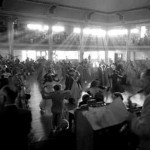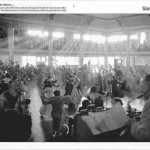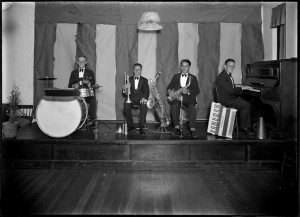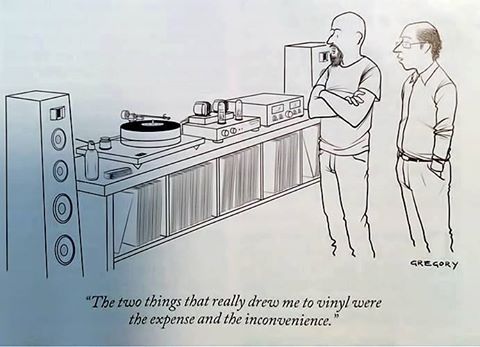This plan of the ballroom was posted by Felix Berghäll on his wall recently, and I noticed that the band stage was on the long wall of a rectangular room. This is pretty much the opposite of the way we set up rooms for concerts usually. But it makes much better sense if you want to be sure a room can see the band, from the dance floor or tables.
Looking at photos of the Cloudland ballroom, it also has the stage on the long wall.
I use a fair few ballrooms and dance halls around the place, from square ones (the lovely Annandale Town Hall) to round ones (the gorgeous Famous Spiegeltent). My preference as a DJ is a round room, or to have the DJ/band on the long wall of a rectangular room, so that it’s right in the ‘middle’ of things. It’s also better for sound, because the speakers don’t have to ‘throw’ down a loooong room. They can radiate from the middle of the room.
This is an issue for me at the moment, as I’m thinking about the dance we’re holding on the Saturday of the Little Big Weekend 13-15 May 2016 . It’s in the Glebe Town Hall, which is pretty much perfect. But it’s long and narrow, with a teeny-tiny (and wholly inadequate) stage in one corner.
So I was thinking we’d put the band on the long wall (opposite a large double door).
Question: will this leave us room to have a competition in front of the band? Asking for a friend*.
*Myself. I am my own friend.
Ah, the Leichhardt town hall.
With your novelty corrugated iron roof and bizarro colour scheme. You are affordable, you’re centrally located, and interesting. But you are also perfectly oriented so as to never catch a breeze, and your hideous 1950s added front-bit makes you so hot the floor wax melts. I have never been in a venue so hot. Mid-winter, and I thought I might actually boil alive in there.
Cloudland Ballroom
Ah, Brisbane under Joh. A horrible time for everyone. In 1982 the Deen Bros did as they’d done (and would do) a million times more, they tore down a historic Brisbane building at the government’s instruction, and with dubious legality.
Cloudland Ballroom. Here are a bunch of photos to make you feel sad.
Andrew Dickeson’s Blue Rhythm Band
Andrew Dickeson’s Blue Rhythm Band.
http://bluerhythmband.org/
I wrote this email the afternoon after Jazz with Ramona.
My only regret is that I don’t have any sound files or video to flaunt this band’s mad skills.
Hi everyone,
I had to write to you immediately to tell you about the band we used last night at the Jazz with Ramona weekend: Andrew Dickeson’s Blue Rhythm Band.
I’ve been looking for small to medium sized band that just plays good, solid swing. I’ve been working with Andrew for a while on putting together the right line up, charts, and set structure, he’s done a gig for me with this band before, and played in lots of other bands for, but last night…
I was just amazed.
It was like someone shoved Basie’s band into a four piece. Andrew is gifted drummer and jazz historian (he teaches jazz at the Conservatorium here in Sydney), but more importantly, he really understands what lindy hoppers are looking for in a band. And he has spectacular taste. He not only played great arrangements, be combined the songs inside the set the way a the best DJ would. I was amazed. I just couldn’t believe how good it was. And the musicians play by ear, with some strong leadership and collaboration on who solos when. Andrew invited Mona to tap with him, and it was integrated so well into the band, it was like she was just another musician. It was riveting.
They play classic solid swing. Four on the floor and no cheating – perfect for lindy hopping. Song-wise, they played the things we want. King Porter Stomp. Swinging the blues (the ~150bpm version). Moten Swing. Doodlin’. Jumpin at the Woodside. Jeep is Jumpin’, Flying Home. And they knew how to work the tempos to suit what the dancers could handle, but also to adjust the energy in the room. Playing together, they’d call things like “King Porter’s Stomp, but brighten it up and put some energy in it,” or “Jeep, but go in heavy”. I can’t believe a 4 piece can play a song like Jumpin’ at the Woodside and make it feel like a big band.
Anrdrew’s also very good to work with.
His email: swingishere1234@gmail.com
His phone number: +61 401 354 897
Website: http://bluerhythmband.org/
I cannot recommend this band enough. I have him booked for all three nights of the Little Big Weekend in May, putting together a 4piece, a slightly larger band, and then a 3 piece barrelhouse band. I have absolute confidence in his ability to give each band a different flavour, and to deliver top shelf swinging jazz to my brief.
More importantly, Lennart declared this band very nice and actually went in a jam of his own free will in October. They are that good.
If you book him, I’ll be there.
Breaks
Often instrumental blues used ‘riffs,’ also – single rhythmic phrases repeated over and over, as a background to the melody, or as the melody itself. Jazz today uses riffs. It also uses ‘breaks,’ which come from the blues. At the end of a phrase of melody or words, there is a little pause, during which one or more instruments break away from the melody and make up some fill-in music (pg 20).
This is why I get angry when I watch dancers ‘hit’ all breaks by standing still. If a musician or band leaves you some space, you should fill it. Not every time, but often enough to show you’re listening. This is also why we teach our beginners about break steps in their first or first class. First you set up the rhythm, then you break it. You aren’t just dead weight in this song; you have to bring something to the party, because you are part of the band. When someone calls, you respond.
Teaching and joy
We’re doing some quite interesting classes on our Wednesday nights at the moment. They are all by-request, which means the topics are quite varied. We did a ‘big apple contest’ class open to everyone (most excellent fun), we’re doing a ‘Social dancer’s history of jazz’ class next week (open to everyone again), a ‘steals’ class the week after, and this week we’re doing a class on how to combine 6 and 8 count steps.
I’d ordinarily avoid a class on ‘steals’ because it feels like one of those gimmick classes. But as one of our other teachers said, “If we want to foster those lindy hop traditions like birthday jams, we have to teach them how to steal.” And because our classes are more like structured self-guided learning a lot of the time, it’s the perfect chance for people to experiment with the concept.
The more I thought about it, the more convinced I became. Especially when I thought about it as just another example of how to understand phrasing, and to read another dancer’s body and feels. So while we’ll be looking at how to get into a birthday jam and ‘steal’, we’ll be talking about how to prepare for the beginning of a phrase, how to read a couple’s dancing to see if it’s time to interrupt or not (eg don’t butt in on a big rhythm break), how to ‘cut in’ in a respectful, efficient way, etc etc. And it’s really just a dancing game that teaches us how to partner dance.
The one we’re doing this week is about combining 6 and 8 count moves. More specifically, a follow requested we look at how follows know whether a move is 6 or 8 count. I’m always a bit surprised by these questions, because I simply don’t think about it when I dance. When I lead, I am absolutely not thinking ‘Here is an 8 count move, now I’m doing a 6 count move.’ I just move through space responding to my partner and to the music. If a triple step is nice here, I put it in. If I need to turn or move quickly, I use a triple step. If I’m hitting a break, I might add in a bit of rhythmic flourish. I leave it to the follow to decide whether they need to triple step or kick ball change or step or kick or whatever. This isn’t 2003: I don’t micro-lead. As if I ever did.
But then I thought about what I do when I’m following. Again, I don’t think ‘6’ or ‘8’ as I’m moving through steps. But what I do do, is use the steps that get me through the shapes most efficiently (or most pleasingly). So I might use a triple step to move quickly through a turn (I rarely spin), I might use a kick/bounce combination to get through a pivot. And so on. Again, I use what gets me through the space I need to cover. I’m moving through the music (ie through time) at the rate my partner asks. And a 6 count move is just moving through a shape 2 beats faster than in an 8 count.
What it made me realise was that perhaps we’d over-emphasised the ‘basic rhythm’ as an 8 count. Perhaps we’d given the impression that an ‘8 count move’ has to be a particular rhythm. When we all know that a move can be any count, and we regularly use 2, 4, 6, 8, and 10 count steps in our lindy hop. So there may be a couple of issues here that we need to address.
First, that the steps you dance (ie the rhythm ‘blocks’ – triple steps, steps, etc) are really whatever gets you through the shape most efficiently (or pleasingly). As a follow, your lead begins the move, suggesting a speed at which to move through the move. Because the connection is a two-way thing, the lead can ‘ask’ you to maintain that particular speed throughout the move, particularly if they hear something in the music and have something planned. But a good lead is listening to the follow, and a good following listening to the lead, so you’re paying attention to the connection. And if the lead asks you to maintain that initial speed and direction (or intensity!) it’s nice to do that. Because lindy hop is a partnership. But as a follow, you get to finish the move, and if that means you take 2 more counts than they’d suggested, that’s ok. So long as you keep to the ‘spirit’ of the move, or the vibe the lead is setting down.
[NB Ramona talked about this in classes the other week: the lead begins the move, the follow finishes it. So leads need to let follows finish the move.]
[Other NB I’m beginning to be convinced that leading and following are very different things. It’s not just the same issues of biomechanics applied differently. Leads have a different timing to follows; leads are closer to the beat, a little ahead, the follows a little behind. So to me, the lead is the cab of a semi trailer, and the follow the long trailer. So as a lead, you need to account for that delay when you lead – the follow will get there a tiny bit later than you. I’ve also discovered that it’s this that I find really, really difficult to change when I swap between roles. I’m beginning to think I need to specialise in just one role to really improve. And you have to be as good as Ramona to do both really well.]
I think this is where the real problem comes for a lot of our follows who go social dancing with leads who work in other paradigms. Those leads think ‘ok, I’m doing move X’ and then they set it in motion, but are already thinking about or moving on to the next move before the follow has completed the first move. They don’t allow for the follow’s slight delay in addition to the ‘time’ it’ll take to do the move. In other words, they can’t think beyond their own experience of time during a song.
This means that you get a lot of leads who rush follows through (for example), the final triple step of a swing out, so the follow starts rushing in on 1, instead of really using that last triple step to get momentum into their body. Even more upsettingly, you get a swing out that stops and starts in hard breaks at 8 and 1. And of course the ‘swing’ falls out completely, as everyone rushes rushes rushes to get through the move.
Secondly, the rhythm blocks you use are both functional and creative. So a triple step is great for moving through space quickly (eg on the turn of a swing out), but also wonderful because it’s a syncopated, swinging rhythm that works so nicely with swinging jazz. It’s not like a cha-cha-cha rhythm. Triiii ple-step. Or tri-PLE-step. Varying the accent on a triple step is super fun, and understanding the difference between a triple step and step-stomp-off is also super fun.
Thirdly, this ‘8 count’ structure is something dancers enforce on the 4/4 timing of jazz. The musicians don’t think in 8s. The 2, 4, 6, 8 is a structure that we either build into the song, or we force on top of it. I think it’s better to build it in. So we listen to the music, and find ways to emphasise what’s going on in the song, using our different rhythm blocks, combined over particular lengths of time. And we use even numbers/counts because that’s where the emphasis is in swing. I prefer to think about a song as one long series of beats in time. Some of the beats are emphasised. Some groups of beats are emphasised. Some musicians only play some of the beats. And so on.
So the most important part of dancing is that you carry that consistent beat within your body all the time. All your movements must come from this, both in a creative sense, but also in terms of biomechanics. You use the ‘bounce’ or engagement of core muscles to make a pivoting kick work. You use the ‘groove’ to connect with your partner and the music.
Anyhoo, because I find it so difficult to understand why people have trouble distinguishing between 6 and 8 (or want to distinguish), I’m really looking forward to the session. We have some fun exercises set up, and that group has lots of opinions, so I’m really keen to learning more about how they’re thinking about music.
Teaching. Could anything be better? No.
Not all ballrooms…
vinyl
more about safety
 I’ve been fussing over what to put on a paper version of our code of conduct to have at all our classes and parties. Until I realised I could just use the ‘back’ of the Jazz with Ramona program I developed.
I’ve been fussing over what to put on a paper version of our code of conduct to have at all our classes and parties. Until I realised I could just use the ‘back’ of the Jazz with Ramona program I developed.
SORTED.
When I get more time I’ll break up the text a bit or add some amusing line drawings or something.
btw, I’m fine with people using the content from this document.
BUT it is far more important to develop your own, so:
- It reflects the culture of your organisation,
- You actually understand and really believe everything in the document (ie haven’t just cut and pasted something out of obligation).
- It works well as part of your broader safety strategies – how does it relate to your online policy document/page? Do all your staff understand it, and have they been trained in (and know how to) apply it? Do YOU know how to use it when you have to actually ban/warn/press charges against offenders?
It’s a gloriously light-touch way of teaching
This is the most important thing I’ve learnt about teaching dance:
As Jane Williams-Siegfredsen, the author of a book on Danish forest kindergartens, puts it: “There’s this thing where the pedagogue needs to stand back sometimes and not always jump in and help the child. They need to let the child overcome problems themselves. We learn so much more from doing that.” (Kids Gone Wild 23 Feb 2016)
I really enjoy this approach to teaching. You give the students a task (use your rhythm to move around the room), and then you let them do it. You don’t interrupt them to ‘fix’ things, you just let them do it, and fix it themselves. They learn so much from this approach.
After you do the exercise, you get together in the group and say “Ok, what did you observe? What was hard? Easy?” You take questions, and you tell them things you saw that you really liked. “I liked the way X and Y stopped and grooved on the spot a bit when they got out of time. I didn’t get run into once, because you’re all being very safe and keeping your feet under your body – I loved that.” And when they ask questions (they will), they say things like, “How do you know when the lead is going to start moving?” and then you add more info about how to be in closed position and how to give and receive information through your body to your partner. After you give that new information, they must dance on it immediately. And you must only say one thing – to the leads, and to the follows.
It’s a gloriously light-touch way of teaching, and I adore it. You don’t see ‘perfect’ dancing right away, but you see people learn to communicate, to lead and follow, and to social dance to music. Most importantly, they keep their own individual style and you can see their personalities come out. It’s also nice because it teaches them to see difficult stuff not as a ‘problem’ or ‘getting it wrong’, but something to figure out and explore with a partner. To me, this is most excellent learning and teaching: you’re helping people figure out that they have the skills they need to learn, and you’re with them as they get started on the lovely long process of dancing.





















